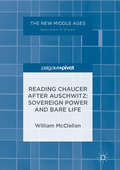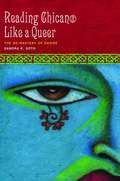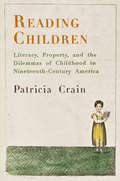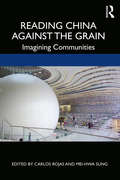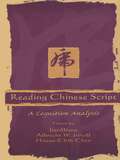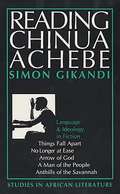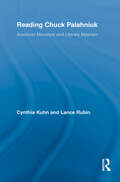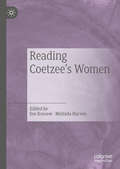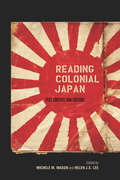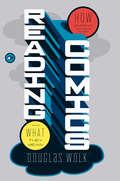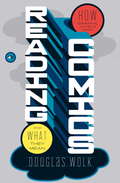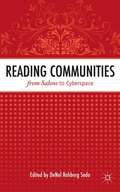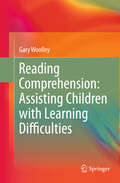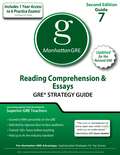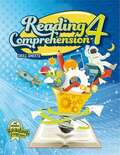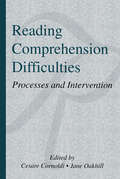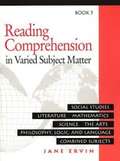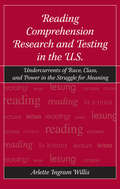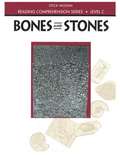- Table View
- List View
Reading Chaucer After Auschwitz
by William McclellanDrawing on the work of Holocaust writer Primo Levi and political philosopher Giorgio Agamben McClellan introduces a critical turn in our reading of Chaucer. He argues that the unprecedented event of the Holocaust, which witnessed the total degradation and extermination of human beings, irrevocably changes how we read literature from the past. McClellan gives a thoroughgoing reading of the Man of Law's Tale, widely regarded as one of Chaucer's most difficult tales, interpreting it as a meditation on the horrors of sovereign power. He shows how Chaucer, through the figuration of Custance, dramatically depicts the destructive effects of power on the human subject. McClellan's intervention, which he calls "reading-history-as-ethical-meditation," places reception history in the context of a reception ethics and holds the promise of changing the way we read traditional texts.
Reading Chican@ Like A Queer
by Sandra K. SotoA race-based oppositional paradigm has informed Chicano studies since its emergence. In this work, Sandra K. Soto replaces that paradigm with a less didactic, more flexible framework geared for a queer analysis of the discursive relationship between racialization and sexuality. Through rereadings of a diverse range of widely discussed writers--from Am rico Paredes to Cherr e Moraga--Soto demonstrates that representations of racialization actually depend on the sexual and that a racialized sexuality is a heretofore unrecognized organizing principle of Chican@ literature, even in the most unlikely texts. Soto gives us a broader and deeper engagement with Chican@ representations of racialization, desire, and both inter- and intracultural social relations. While several scholars have begun to take sexuality seriously by invoking the rich terrain of contemporary Chicana feminist literature for its portrayal of culturally specific and historically laden gender and sexual frameworks, as well as for its imaginative transgressions against them, this is the first study to theorize racialized sexuality as pervasive to and enabling of the canon of Chican@ literature. Exemplifying the broad usefulness of queer theory by extending its critical tools and anti-heteronormative insights to racialization, Soto stages a crucial intervention amid a certain loss of optimism that circulates both as a fear that queer theory was a fad whose time has passed, and that queer theory is incapable of offering an incisive, politically grounded analysis in and of the current historical moment.
Reading Children: Literacy, Property, and the Dilemmas of Childhood in Nineteenth-Century America
by Patricia CrainWhat does it mean for a child to be a "reader" and how did American culture come to place such a high value on this identity? Reading Children offers a history of the relationship between children and books in Anglo-American modernity, exploring long-lived but now forgotten early children's literature, discredited yet highly influential pedagogical practices, the property lessons inherent in children's book ownership, and the emergence of childhood itself as a literary property.The nursery and schoolroom version of the social contract, Crain argues, underwrote children's entry not only into reading and writing but also into a world of commodity and property relations. Increasingly positioned as an indispensable form of cultural capital by the end of the eighteenth century, literacy became both the means and the symbol of children's newly recognized self-possession and autonomy. At the same time, as children's legal and economic status was changing, "childhood" emerged as an object of nostalgia for adults. Literature for children enacted the terms of children's self-possession, often with explicit references to property, contracts, or inheritances, and yet also framed adult longing for an imagined past called "childhood."Dozens of colorful illustrations chart the ways in which early literature for children was transformed into spectacle through new image technologies and a burgeoning marketplace that capitalized on nostalgic fantasies of childhood conflated with bowdlerized fantasies of history. Reading Children offers new terms for thinking about the imbricated and mutually constitutive histories of literacy, property, and childhood in the eighteenth and nineteenth centuries that ground current anxieties and long-held beliefs about childhood and reading.
Reading China Against the Grain: Imagining Communities
by Carlos Rojas; Mei-hwa SungThrough an analysis of a wide array of contemporary Chinese literature from inside and outside of China, this volume considers some of the ways in which China and Chineseness are understood and imagined. Using the central theme of the way in which literature has the potential to both reinforce and to undermine a national imaginary, the volume contains chapters offering new perspectives on well-known authors, from Jin Yucheng to Nobel Prize winning Mo Yan, as well as chapters focusing on authors rarely included in discussions of contemporary Chinese literature, such as the expatriate authors Larissa Lai and Xiaolu Guo. The volume is complemented by chapters covering more marginalized literary figures throughout history, such as Macau-born poet Yiling, the Malaysian-born novelist Zhang Guixing, and the ethnically Korean author Kim Hak-ch’ŏl. Invested in issues ranging from identity and representation, to translation and grammar, it is one of the few publications of its kind devoting comparable attention to authors from Mainland China, authors from Manchuria, Macau, and Taiwan, and throughout the global Chinese diaspora. Reading China Against the Grain: Imagining Communities is a rich resource of literary criticism for students and scholars of Chinese studies, sinophone studies, and comparative literature
Reading Chinese Script: A Cognitive Analysis
by Jian Wang Hsuan-Chih Chen Albrecht W. InhoffThis volume uses unique properties of Chinese script to focus on morphological analyses during the character and word recognition process, though some of the reported work also pertains to the use of phonological information. In addition, this volume contains work on syntactic and pragmatic processes during sentence reading and three chapters that examine on-line processes. A comprehensive appraisal of cognitive processes during the reading of Chinese script that includes studies conducted by leading researchers from within and outside the mainland, this volume will be of interest to all those studying reading and visual symbol processing.
Reading Chinua Achebe: Language And Ideology In Fiction
by Simon GikandiSimon Gikandi has set out to reveal '...the very nature of [Achebe's] creativity, its prodigious complexity and richness...its paradoxes and ambiguities. This is scholarship of real stature and supersedes all other studies of Achebe's writing. It comes at a good time. Achebe's literary reputation is equal to that of any living author and a substantial critical canon has been established. - G.D. Killam, Professor of English, University of Guelph
Reading Chuck Palahniuk: American Monsters and Literary Mayhem (Routledge Studies in Contemporary Literature)
by Cynthia Kuhn Lance RubinReading Chuck Palahniuk examines how the author pushes through a variety of boundaries to shape fiction and to question American identity in powerful and important ways. Palahniuk's innovative stylistic accomplishments and notoriously disturbing subject matters invite close analysis, and the new essays in this collection offer fascinating insights about Palahniuk's texts, contexts, contributions, and controversies. Addressing novels from Fight Club through Snuff, as well as his nonfiction, this volume will be valuable to anyone with a serious interest in contemporary literature.
Reading Circle class 10 - Meghalaya Board
by Meghalaya Board of School EducationThe Reading Circle books offer a wide selection of texts for students of classes 9 and 10. The readers contain fables, legends, folk tales and short stories—a representative selection from international as well as Indian literature—and also extracts from the classical and contemporary prose of some of the most highly regarded authors in the English language. Each selection has been made with care, and has been abridged or simplified, where necessary, to suit the appropriate language level of the student. This rich treasure trove of literature will stimulate the child’s imagination. The books contain stories of excitement and adventure, heroism and romance. Great care has been taken to incorporate value-based and environmental themes. To enable the students to identify and appreciate the themes more readily, humour and liveliness form an integral part of these stories. It is hoped that appreciation of the stories presented in the Reading Circle will encourage students to delve deeper into the glorious world of English literature.
Reading Class through Shakespeare, Donne, and Milton
by Christopher WarleyWhy study Renaissance literature? Reading Class through Shakespeare, Donne, and Milton examines six canonical Renaissance works to show that reading literature also means reading class. Warley demonstrates that careful reading offers the best way to understand social relations and in doing so he offers a detailed historical argument about what class means in the seventeenth century. Drawing on a wide range of critics, from Erich Auerbach to Jacques Ranciere, from Cleanth Brooks to Theodor Adorno, from Raymond Williams to Jacques Derrida, the book implicitly defends literary criticism. It reaffirms six Renaissance poems and plays, including poems by Donne, Shakespeare's Hamlet, and Milton's Paradise Lost, as the sophisticated and moving works of art that generations of readers have loved. These accessible interpretations also offer exciting new directions for the roles of art and criticism in the contemporary, post-industrial world.
Reading Coetzee's Women
by Melinda Harvey Sue KossewThis is the first book to focus entirely on the under-researched but crucial topic of women in the work of J. M. Coetzee, generally regarded as one of the world’s most significant living writers. The fourteen essays in this collection raise the central issue of how Coetzee’s texts address the ‘woman question’. There is a focus on Coetzee’s representation of women, engagement with women writers and the ethics of what has been termed his ‘ventriloquism’ of women’s voices in his fiction and autobiographical writings, right up to his most recent novel, The Schooldays of Jesus. As such, this collection makes important links between the disciplines of literary and gender studies. It includes essays by well-known Coetzee scholars as well as by emerging scholars from around the world, providing fascinating and timely global insights into how his works are read from differing cultural and scholarly perspectives.
Reading Colonial Japan: Text, Context, and Critique
by Mason Michele M. Lee Helen J. S.By any measure, Japan's modern empire was formidable. The only major non-western colonial power in the 20th century, Japan controlled a vast area of Asia and numerous archipelagos in the Pacific Ocean. The massive extraction of resources and extensive cultural assimilation policies radically impacted the lives of millions of Asians and Micronesians, and the political, economic, and cultural ramifications of this era are still felt today. The Japanese empire lasted from 1869-1945. During this time, how was the Japanese imperial project understood, imagined, and lived?Reading Colonial Japanis a unique anthology that aims to deepen knowledge of Japanese colonialism(s) by providing an eclectic selection of translated Japanese primary sources and analytical essays that illuminate Japan's many and varied colonial projects. The primary documents highlight how central cultural production and dissemination were to the colonial effort, while accentuating the myriad ways colonialism permeated every facet of life. The variety of genres the explored includes legal documents, children's literature, cookbooks, serialized comics, and literary texts by well-known authors of the time. These cultural works, produced by a broad spectrum of "ordinary" Japanese citizens (a housewife in Manchuria, settlers in Korea, manga artists and fiction writers in mainland Japan, and so on), functioned effectively to reinforce the official policies that controlled and violated the lives of the colonized throughout Japan's empire. By making available and analyzing a wide-range of sources that represent "media" during the Japanese colonial period,Reading Colonial Japandraws attention to the powerful role that language and imagination played in producing the material realities of Japanese colonialism.
Reading Comics
by Douglas WolkSuddenly, comics are everywhere: a newly matured art form, filling bookshelves with brilliant, innovative work and shaping the ideas and images of the rest of contemporary culture. In "Reading Comics," critic Douglas Wolk shows us why this is and how it came to be. Wolk illuminates the most dazzling creators of modern comics-from Alan Moore to Alison Bechdel to Dave Sim to Chris Ware-and introduces a critical theory that explains where each fits into the pantheon of art. "Reading Comics" is accessible to the hardcore fan and the curious newcomer; it is the first book for people who want to know not just what comics are worth reading, but also the ways to think and talk and argue about them.
Reading Comics: How Graphic Novels Work and What They Mean
by Douglas WolkSuddenly, comics are everywhere: a newly matured art form, filling bookshelves with brilliant, innovative work and shaping the ideas and images of the rest of contemporary culture. In Reading Comics, critic Douglas Wolk shows us why and how. Wolk illuminates the most dazzling creators of modern comics-from Alan Moore to Alison Bechdel to Chris Ware-and explains their roots, influences, and where they fit into the pantheon of art. As accessible to the hardcore fan as to the curious newcomer, Reading Comics is the first book for people who want to know not just which comics are worth reading, but ways to think and talk and argue about them.
Reading Communities from Salons to Cyberspace
by Denel Rehberg SedoReading is both a social process and a social formation, as this book illustrates across centuries and cultural contexts. Highlighting links evident in reading communities from literary salons to online environments, each essay reflects the rich repertoire of research methods available to reading scholars.
Reading Comprehension
by Jean Lisa Mollie Hancock Richert BrittenumThis collection of fascinating readings with follow-up activities is designed to be an effective tool for developing comprehension and vocabulary skills. The follow-up activities encompass such basic skills as author's purpose, fact or opinion, skimming, reading for details, vocabulary, compare/contrast, time sequence, main idea, referents, and many more. An extension activity is also provided with each reading to be used for enrichment or as a "challenge" for those who finish early.
Reading Comprehension
by Gary WoolleyReading Comprehension: Assisting Children with Learning Difficulties examines the complex nature of reading comprehension. It introduces a model for classifying reading comprehension based on an expanded Simple View of Reading. Issues related to assessment, diagnosis, and remediation of reading comprehension difficulties are discussed and translated into clear recommendations to inform reading intervention design and practice. It gives an informed understanding as to why reading comprehension is difficult for some children with learning disabilities such as ADHD, autism, language difficulties and dyslexia. From leading literacy research, the book develops a deeper understanding of thinking processes that facilitate comprehension at the word, discourse, and metacognitive levels. Children will benefit from the introduction of evidence-based methods for teaching reading comprehension using structured multiple-strategy frameworks.
Reading Comprehension & Essays: GRE Verbal Strategy Guide
by The Editors at the Manhattan GREUpdated for the revised GRE, the Reading Comprehension and Essays Guide provides a comprehensive approach to Reading Comprehension passages and questions on the GRE. It contains practical techniques for grasping difficult, unfamiliar content and perceiving passage structure rapidly and will teach you how to attack questions through effective classification and analysis.<P> Each chapter explains core principles and builds fundamental skills through numerous, in-depth examples and exercises. The chapter on Essays equips you to write excellent responses on the Analytical Writing section of the GRE, while handy analytical tools allow you to identify critical flaws in given arguments.
Reading Comprehension 3 Skill Sheets
by Abeka BooksEvaluate your child’s reading comprehension with 36 weekly reading activities with comprehension checks covering a variety of topics including natural resources, weather, research, recipes, flyers, and poems. Each story comes with a specified amount of time in which to read and comprehension questions to answer. The questions and activities are built on literary concepts developed throughout the reading program. Stimulate your child’s reading interest and help them improve their speed and comprehension skill through these informative stories.
Reading Comprehension 4 Skill Sheets
by AbekaThis workbook contains a full year of informative, narrative, and poetic selections designed for silent reading and evaluation. The activity sheets begin with recall questions for optional grading and build to critical thinking questions for recognizing and reinforcing literary concepts. <p><p>With this book, your students will develop essential reading skills and retain the important elements presented within a story.
Reading Comprehension 4: Skills Sheets
by Abeka BooksAssess your child’s reading comprehension skills throughout the year with Abeka’s Reading Comprehension 4 Skill Sheets. Poems, brief stories, and non-fiction passages are paired with activity sheets that give recall and critical thinking questions that will help your child build essential reading skills. Answers are located in the Reading Comprehension 4 Skill Sheets Teacher Edition (sold separately). 88 pages, softcover. Grade 4.
Reading Comprehension Difficulties: Processes and Intervention
by Jane Oakhill Cesare CornoldiRecognizing the characteristics of children with learning disabilities and deciding how to help them is a problem faced by schools all over the world. Although some disorders are fairly easily recognizable (e.g., mental retardation) or very specific to single components of performance and quite rare (e.g., developmental dyscalculia), schools must consider much larger populations of children with learning difficulties who cannot always be readily classified. These children present high-level learning difficulties that affect their performance on a variety of school tasks, but the underlying problem is often their difficulty in understanding written text. In many instances, despite good intellectual abilities and a superficial ability to cope with written texts and to use language appropriately, some children do not seem to grasp the most important elements, or cannot find the pieces of information they are looking for. Sometimes these difficulties are not immediately detected by the teacher in the early school years. They may be hidden because the most obvious early indicators of reading progress in the teacher's eyes do not involve comprehension of written texts or because the first texts a child encounters are quite simple and reflect only the difficulty level of the oral messages (sentences, short stories, etc.) with which the child is already familiar. However, as years go by and texts get more complex, comprehension difficulties will become increasingly apparent and increasingly detrimental to effective school learning. In turn, studying, assimilating new information, and many other situations requiring text comprehension -- from problem solving to reasoning with linguistic contents -- could be affected. Problems with decoding, dyslexia, and language disorders have attracted more interest from researchers than have specific comprehension problems and have occupied more room in specialized journals. Normal reading comprehension has also been a favorite with researchers. However, scarce interest has been paid to subjects who have comprehension difficulties. This book is an attempt to remedy this situation. In so doing, this volume answers the following questions: * Does a reading comprehension problem exist in schools? * How important and widespread is the problem? * Is the problem specific? * How can a reading comprehension difficulty be defined and identified? * Does the "syndrome" have a single pattern or can different subtypes be identified? * What are the main characteristics associated with a reading comprehension difficulty? * When can other well-identified problems add to our understanding of reading comprehension difficulties? * Which educational strategies are effective in preventing and treating reading comprehension difficulties? * What supplementary information can we get from an international perspective?
Reading Comprehension In Varied Subject Matter (Reading Comprehension #Book 5)
by Jane ErvinThis popular series offers nonfiction reading passages with comprehension questions on a variety of subjects for students in second grade through junior high school and beyond. Topics and questions prepare students for standardized tests and provide valuable practice in nonfiction reading comprehension. The entire Reading Comprehension series is particularly useful in a classroom that has students of varying reading abilities. <p><p> Themes such as "Great Americans" and "What Do You Think?" reappear in each book, with the exact focus of the passage changing according to the level of the material. Reading Comprehension Used successfully by classroom teachers, tutors, ESL teachers, and parents, these workbooks have been revised and updated, with the addition of new reading selections, new vocabulary, and a new writing exercise. Each workbook has 31 selections in these subject areas: social studies; science; literature; mathematics; philosophy, logic, and language; the arts; and combined subjects. Each book in this series is arranged thematically. <p> The themes relate the selections to one another, show different aspects of a topic, and give students a broader knowledge of a subject. Each selection follows a consistent format 7-step format in presenting the passage, and includes exercises on vocabulary and writing. Skills Addressed: Story recall; Sequencing; Drawing conclusions; Vocabulary development; Main idea; Extending thoughts in writing; Inference.
Reading Comprehension Research and Testing in the U.S.: Undercurrents of Race, Class, and Power in the Struggle for Meaning
by Arlette Ingram WillisThis book challenges traditional, sanctioned, and official histories of reading comprehension by examining how ideological and cultural hegemony work to reproduce dominant ideologies through education in general and reading comprehension research and testing specifically. Willis analyzes the ideological and cultural foundations that underpin concepts, theories, research, tests, and interpretations, and connects these to the broader social and political contexts within U.S. history in which reading comprehension research and testing have evolved. The reconstruction of a history of reading comprehension research and testing in this way demystifies past and current assumptions about the interconnections among researchers, reading comprehension research, and standardized reading comprehension tests. A promising vision of the future of reading comprehension research and testing emerges–one that is more complex, multidimensional, inclusive, and socially just. Reading Comprehension Research and Testing in the U.S. aims to revolutionize how reading comprehension is conceived, theorized, tested, and interpreted for all children. This is a critically relevant volume for educational researchers, teacher educators, school administrators, teachers, policy makers, and all those concerned with school literacy and educational equity.
Reading Comprehension Series-Level C: Bones and Stones
by Martha K. Resnick Carolyn J. HyattConcentrates on sequentially building vocabulary and comprehension skills.
Reading Comprehension in Varied Subject Matter Book 8
by Jane ErvinThis series has a consistent format that allows students in the same class to use different levels. It builds reading comprehension skills, contextual vocabulary skills, and provides cross-curricular reading practice via content-area topics.
